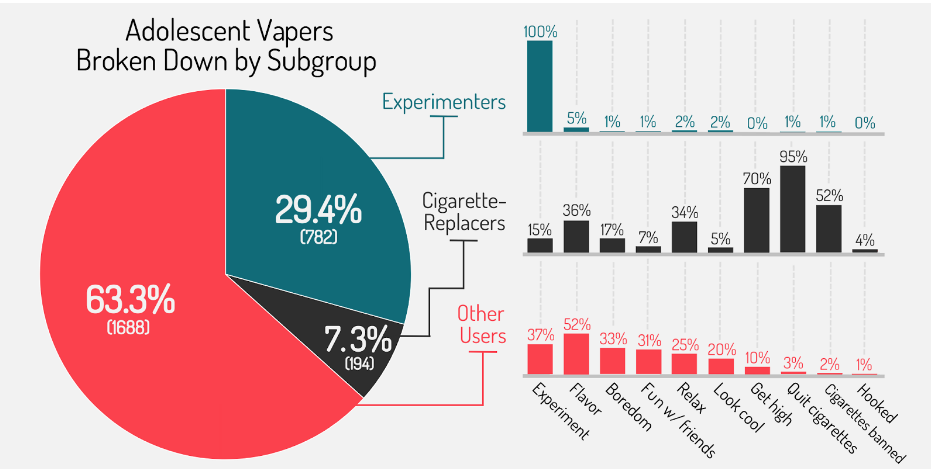Vaping is popular among adolescents, but has negative health consequences including increased chance of future smoking and substance use. While experimentation and flavoring seem to be the most popular reasons for vaping in this population, we still don’t know very much about adolescents’ reasons for vaping. This week, ASHES reviews a study by Rebecca Evans-Polce and colleagues that explored why adolescents vape.
What was the research question?
Among U.S. adolescents, what are common reasons for vaping?
What did the researchers do?
The researchers used data from Monitoring the Future, an annual cross-sectional health survey of U.S. 12th graders. The sample included 2,664 participants in the 2015 and 2016 surveys who reported vaping in their lifetime. Participants indicated which of ten possible reasons compelled them to vape: to experiment, because of the taste, because of boredom, to have fun with friends, to relax, because it looks cool, to get high, to help quit regular cigarettes, because cigarette use is not permitted, or because they need it. The researchers used latent class analysis to split participants into subgroups based on reasons for vaping.
What did they find?
Evans-Polce and colleagues identified three different subgroups of adolescent vapers:
- Experimenters (29.4% of the sample): These adolescents vaped to try it out and rarely endorsed any other reason.
- Cigarette-Replacers (7.3% of the sample): These adolescents vaped primarily to quit cigarettes, or because cigarettes were not allowed in places they frequented.
- Other Users (63.3% of the sample): These adolescents did not fit into the other subgroups and vaped for a variety of reasons. Interestingly, more than half of this subgroup reported vaping for the flavor (see figure).
Overall, experimentation and enjoying the flavor were the most popular reasons for vaping (endorsed by 55% and 37% of the sample, respectively). Fewer participants vaped to quit regular cigarettes or because cigarettes were prohibited (both endorsed by less than 10% of the sample).

Figure. Left: The entire sample of adolescents broken down by subgroup. Right: Percentages of vapers per group who endorsed each reason. Click image to enlarge.
Why do these findings matter?
Most adolescents in this sample had diverse motivations, including the flavor. The popularity of flavor suggests that adolescent vape culture differs from alcohol and marijuana use in its emphasis on taste. The U.S. Food and Drug Administration plans to limit access to e-cigarette flavorings in response, but this policy change might have little effect on Experimenters and Cigarette-Replacers, who together made up about 37% of the sample.
Every study has limitations. What are the limitations in this study?
The sample was limited to high school seniors in the U.S., so the study did not consider high schoolers who dropped out before 12th grade. These adolescents are more likely to use substances than those who finish high school. Self-reporting sensitive information pertaining to vaping and substance use could have resulted in inaccurate data.
For more information:
SmokeFree offers tools and tips quitting and maintaining abstinence from smoking tobacco. American Academy of Child & Adolescent Psychiatry offers parents information, tips, and tools about adolescent e-cigarette and tobacco use. For additional tools, please visit the BASIS Addiction Resources page.
— Jamie Juviler
What do you think? Please use the comment link below to provide feedback on this article.





robin shepherd December 18, 2018
why is there 3 % of ‘other reasons’ to quit in the red graph when the black graph is for those who replaced cigarettes with vaping?
James Juviler December 19, 2018
Hi Robin,
Thanks for your question. Cigarette-Replacers vaped primarily for cigarette-related reasons, meaning that most who endorsed “quit cigarettes” or “cigarettes banned” qualified as a Cigarette-Replacer, but not all. We don’t have data on individual responses, so we can’t know exactly why the analysis sorted participants the way it did. However, it’s likely that the 3% of Other Users you point out endorsed an overall set of reasons more consistent with Other Users than CRs. For example, they could have endorsed a wider range of reasons than CRs.
Best,
Jamie
robin shepherd December 19, 2018
okay it’s still a bit fuzzy. An interesting study though